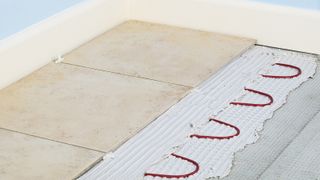Underfloor heating with tiles: Does it work and what are the problems?
Find out everything you need to know about installing underfloor heating with tiles above, with industry expert comments and advice

在stalling underfloor heating with tiles is a great way to heat your home while achieving the flooring finish you desire.
Underfloor heatinghas been a popular alternative to traditional radiators for years thanks to its low running costs and constant comfortable temperature.
Here's our expert guide on everything you need to know about tiles and underfloor heating.
Does underfloor heating work with tiles?
"Tiles are ideal for underfloor heating, particularly low temperature water-based systems, due to their superior longevity and thermal conductivity which ensures a fast heat-up time, making them a highly efficient choice," says James Lloyd, specification consultant fromWunda Group(opens in new tab).
"There are a few different types of underfloor heating, but they all follow the same concept of heating the floor above, either by circulating heated water through plastic pipes or via a heated electric mat underneath the floor, someelectric underfloor heatingsystems use infra-red to do this, but it’s very similar to the electric matting system."

Can all types of underfloor heating be used with tiles?
Both porcelain and ceramic tiles can be laid on top of wet and electric underfloor heating systems. "There are several different types of underfloor heating on the market and each has its own compatibility limits when it comes to the type of flooring material being laid on top," explains Colin Lincoln-Evans, buyer atTile Mountain(opens in new tab).
When buying tiles, it will usually specify whether it is suitable for underfloor heating or not. If it doesn't then double check with the manufacturer.
"However, regardless of whether you’reinstalling underfloor heatingwith a wet system or for [electric underfloor heating installation], it’s important to always use a flexible adhesive such as Mapei Keraquick [like this from Tile Giant(opens in new tab)] and ensure you have the right sub-floor for installation."
Can underfloor heating crack tiles?
"Ensuring the UFH is commissioned correctly and using a flexible adhesive and grout should ensure that the grout and tiles don't crack," explains Colin Lincoln-Evans.
To further reduce the risk of the flooring cracking when laid on top the underfloor heating system, a level floor is essential.
"In an ideal world, underfloor heating systems of all types would be installed atop of a fully cured, fully level concrete screed that is between 60mm and 75mm thick," Colin continues. "If this isn’t possible you should take the greatest effort to ensure that the sub-floor substrate is suitable for your particular underfloor heating installation.
"Making sure that your sub-floor is level is always a good place to start – using levelling compound ahead of installing underfloor heating will help prevent cracking and alleviate any cold/hot spots, as well as disperse the heat evenly and also protect the kits during installation. If installing over non-tongue and groove floorboards or joists then you will need to use a backer board, again, making sure that it is suitable for your type of installation. Once these substrates are in place then you can install the tiles as normal."

什么是最好的瓷砖地板下供暖吗?
"Most types of porcelain and ceramic tiles are suitable for use with underfloor heating, as are natural stone tiles including limestone, marble, slate, terracotta, and quarry tiles," says Tile Mountain's Colin Lincoln-Evans.
"Tiles are the most thermally conductive floor finish, but there are many other everyday options that work well including carpet, engineered wood, laminate and vinyl," adds James Lloyd from Wunda. "Wood effect porcelain tiles gives the 'best of both worlds', as you can have the appearance of wood with the high heat output and fast heat up times of tile."
How to remove tiles with underfloor heating underneath
While it can be difficult to remove floor tiles without damaging the underfloor heating system underneath, it isn't impossible. Hand tools are recommended to first remove the grout before lifting the tiles, but this process is time consuming and the risk of causing issues with the underfloor heating below is very high.
Make sure you pay particular attention to not damaging theunderfloor heating manifoldor any wiring going to theunderfloor heating thermostat.
Can I lay Karndean, wood, carpet or other materials on top of tiles with underfloor heating?
Laying a different flooring type on top of tiles above the underfloor heating system is not generally advised, but if you're looking to change the style and don't want to risk damage by removing the tiles, a thin laminate would be the best option. Some of the residual heat from the tiles should still penetrate through to the top layer, but the effect will be reduced and slowed.
"As a general rule, solid wood flooring isn’t suitable for use with underfloor heating, regardless of whether it’s a ‘wet’ system, a mat kit or cable kit, unless expressly stipulated by the manufacturer," says Colin Lincoln-Evans from Tile Mountain. "Engineered timber however is generally suitable given that is less prone to movement and expansion when subjected to heat and humidity."
You can read more information about different materials with our guides onunderfloor heating with carpetandwooden flooring with underfloor heating.
Get the Homebuilding & Renovating Newsletter
Bring your dream home to life with expert advice, how-to guides and design inspiration, direct to your inbox.
Assistant Editor Amy began working for Homebuilding & Renovating in 2018. She has an interest in sustainable building methods and always has her eye on the latest design ideas. Amy has interviewed countless self builders, renovators and extenders about their experiences for Homebuilding & Renovating magazine. She is currently renovating a mid-century home, together with her partner, on a DIY basis, and has recently fitted her own kitchen.
Most Popular
Thank you for signing up to Homebuilding. You will receive a verification email shortly.
There was a problem. Please refresh the page and try again.
